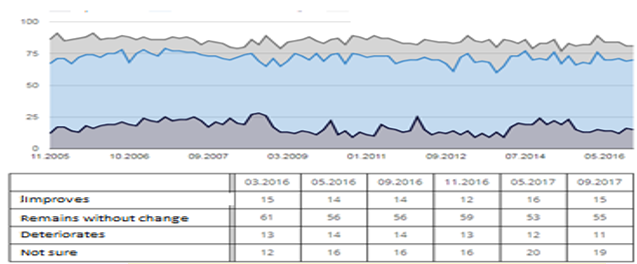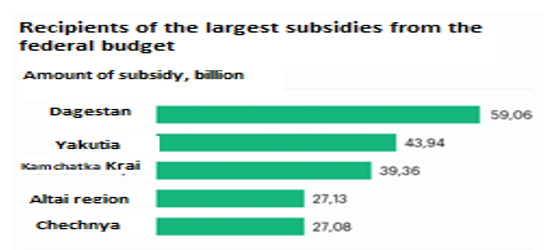Abstract
The North Caucasus is a complex and depressive region of Russia, mainly inhabited by autochthonous peoples who profess Islam and Christianity. A high degree of politicization, ethnicity, clan system, strong tribal connections create the ground for conflict behavior in governing interactions. The main factor in the North Caucasus are the local, regional ethno-political elites, which consist of tajpovost, familnosti, and tukumnost. This article details the process of structuring and behavioral models of elites. The formation of political elites takes place on a closed, guild model, and the incorporation is carried out by entourages on the basis of informal criteria. The authors keep to the reputational approach to the definition of the elite, with its correlation by divisional and altimetric approaches. The presence of real power, formal and latent levers of pressure, influence on decision-making determines the very essence of political elites in the North Caucasus. Such inconsistency and poor quality of elites leads to the emergence of new and escalation of old conflicts, ethnocracies often use for their own mercantile purposes the historical memory of peoples, unresolved territorial disputes, injustice, social differentiation and other problems. The events of 1992 around the disputed suburban area of North Ossetia-Alania, the internal Russian-Chechen conflict of 1994-1996 and 1999-2000, new points of ethno-political tension in Ingushetia, interethnic clashes in Kalmykia, Kabardino-Balkaria indicate the presence of high conflict potential in the region. Archaism, poorly developed institutions of civil society, economic backwardness of the region lead to permanent tension and conflicts.
Keywords: Russiathe North Caucasuspolitical elitespolitical processstructureconflicts
Introduction
Under Boris Yeltsin, the Federal center began a policy of decentralization, to delegate part of its powers to the regions, which triggered a series of domestic and regional conflicts, in particular in the North Caucasus (Gadaev, 2008; Gapurov et al, 2006; Mankiev, Ibragimov, & Zhemchuraeva, 2013). The absence of a Mature political elite, the inability of some regional leaders to soberly assess the situation locally (Magamadov, 2013), leads to new hotbeds of ethnopolitical tension and conflict. For example, since the beginning of October 2018 Ingushetia held demonstrations, rallies, marches, accompanied by public insults of the regional authorities, calling for a change of government, etc. The protesters' claims are reduced to the fact that after the signing of the agreement between the Chechen Republic and the Republic of Ingushetia on the delimitation of the territory on September 26, 2018, Ingushetia allegedly lost a significant part of its lands. Attempts to explain that the exchange of territories was equivalent and took place under the control of the Federal center, failed.
These events show that the lack of coordination and haste of such steps on the part of the ethno-elites, as well as information stuffing and misinformation on the part of political opponents, who hastened to use this very sensitive issue for their own purposes, aggravate the situation. This protest behavior shows that political elites are not always able to articulate the interests of citizens, the weakness of public confidence in the decisions of political and administrative elites, as well as that the population is subject to strong influence of opposition forces, provocateurs and the active role of counter-elites in the political process. For example, the opposition western diaspora hastened to lead the process and promote it. Acclamation behavior (Potseluev, 1999) is very characteristic of this protest behavior. Diametrically opposed attitude to the border problem has developed in the neighboring Chechen Republic (Akhmadov, 2009; Akaev, 2014).

According to Figure

Problem Statement
The functioning of political elites is carried out on a patron-client basis with a strong predominance of political and administrative elites. In this elite organization, there is the leader, the head of the (patron) and a group of helpers, advisers, assistants and so on, that is formed by the clientele. When the patron is moved from one position to another, its clientele moves with it. When the suspension of the patron is destroyed and his cage that can carry a strong reputation losses (former). This elite organization can exist only under the vertical projection, under the auspices of a more influential official.
It carries a fairly strong conflict potential and contradictions (Yusupov, 2012; Yusupov, 2000)
Research Questions
The structuring of political elites is based on three factors – cultural, structural and institutional. The cultural factor is based on the process of legitimation of elites in accordance with the norms of culture, value orientations and stereotypes adopted in society. The structural factor is the organizational boundaries of the elites. Institutional factor is a formal power hierarchy, which is built in accordance with the functions of state bodies.
The structure of political elites is correlated with the monocentric model, where the core of decision-making is the administrative or economic basis. A feature of the Russian political elite is its sectoral and territorial heterogeneity. Formation, institutionalization of elites takes place at Autonomous territorial levels: Federal, regional and local (Gritsenko, 2010).
Within this system, the entry into the elite is slow, gradually, from among the small circle of the selectorate. The selection process is highly institutionalized, formalized and involves a wide range of requirements, it is conducted by a narrow circle of leaders and entourages affiliated with informal leaders (Subbotin, 2015). In the Northern Caucasus this process built on the basis of ethnoclannishness, tajpovost, familnost, tukumnost, nepotism (Vartumjan, 2009). Such an elite system is typical for countries with authoritarian regimes, societies with weak development of democratic and civil institutions (Fishman, 2015).
The entrepreneurial recruitment system for elites is characterized by its openness, less formal requirements for candidates, competition, a lesser degree of institutionality of the selection procedure, the importance of professional and personal requirements, creativity and individuality of qualities
Purpose of the Study
The purpose of the research is to analyze the structure of political elites in the North Caucasus, assess their influence resources and strategies of activity, identify the main causes of ethno-political tensions in the region and the role of elites in these processes and develop basic recommendations for alleviating national and political tensions.
Research Methods
The article uses the general scientific principles of historicism and dialectics. To solve the research problems, a systematic approach is applied, which implies unity and interconnection. At the application layer, the method of document analysis, secondary analysis of sociological research, as well as quantitative procedures for studying elites are used.
Findings
The formation of political elites is built in certain structural and functional frameworks, which include models and mechanisms of organization, algorithms of functioning and recruitment. Transparency, legitimacy of elite circulation channels determine, in the main, its quality and efficiency, political and power status.
The political elites of the North Caucasian republics are characterized by a combination of both competitive and nomenclature principles of organization. Archaism, ethnocratism, tribal principles of incorporation are very typical for this region (Salgiriev, Betilmerzaeva, Shamsuev, & Osmaev, 2018). Education, professional competence, personal qualities are not the main or any important factor of recruitment. Modern political elites of the Russian Caucasus are built on the guild model, intra-elite relations are carried out on the tribal principle.
Conclusion
At the present stage, we are witnessing the centralization of the political vertical, strengthening the role of federal executive bodies, in particular, the introduction of plenipotentiary representatives of the President in federal districts, the creation of federal territorial ministries, the appointment and removal of heads of regions. Such administrative measures were caused by the gradual weakening of the control of the center on the ground, the increasing role of ethnocracies against the background of the "looseness" of governing interactions. It is important to understand that the political elites of the Caucasian republics are able to accumulate and determine ethno-mobilization potential, which leads to the emergence of a certain bargaining with local ethno-elites. Out of the situation in the gradual weakening of the role of elites, the introduction of transport channels for the recruitment and incorporation of elites, the integration of the peoples of the North Caucasus into the all-Russian civilizational and cultural space, the fight against social differentiation by suppressing corruption and the introduction of fair courts, the latter, however, is relevant for the whole country.
References
- Akaev, V. (2014). The history and specifics of contemporary Islamic revival in the Chechen Republic. Anthropology & Archeology of Eurasia, 2, 79-102.
- Akhmadov, Ya. Z. (2009). Essay on historical geography and ethno-political development of Chechnya in the XVI-XVIII centuries. Moscow.
- Fishman, L. G. (2015). Do elites create democracy? Scientific yearbook of the Institute of philosophy and law of the Ural branch of the Russian Academy of Sciences, 2, 61-70.
- Gadaev, V. J. (2008). The problem of spiritual and moral development of modern Chechen youth. History of science and technology, 3, 70-73.
- Gapurov, Sh. A., Akhmadov, Sh. B., Bagaev, M. Kh., Khizriev, Kh. A., Akhmadov, Ya. Z., Khasbulatov, A. I., Isaev, S. A., Badaev, S. E. S., Ibragimova, Z. H. (2006). History of Chechnya from ancient times to the present day. Grozny.
- Gritsenko, N. P. (2010). Regional political elites in modern Russia: resources of influence on the political process. Society and power, 1 (25), 64-69.
- Levada-center, Assessment of the current situation in the country. (2018). Retrieved from: https://www.levada.ru/indikatory/polozhenie-del-v-strane/.
- Magamadov, S. S. (2013). Key questions of the history of the peoples of the North Caucasus 20-30-ies. XX century: achievements and controversial issues. Humanities of the South of Russia, 4, 145-155.
- Mankiev, A. A., Ibragimov, M. M., Zhemchuraeva, S. S. (2013). Chechen type in the historical past and consciousness of modern student youth. Bulletin of the Academy of Sciences of the Chechen Republic, 3, (20), 99-104.
- Mogilevskaja, A. (2017). The largest subsidies from the budget will receive Dagestan, Chechnya and Kamchatka. Available at: https://www.rbc.ru/economics/11/10/2017/59db751d9a794738f67da77e
- Potseluev, S. P. (1999). Symbolic politics: a constellation of concepts for the approach to the problem. Polis. Political research, 5, 62-75.
- Salgiriev, A., Betilmerzaeva, M., Akhtaev, A., Gaziev, V. (2017). Determinants of political violence in the Northern Caucasus: Regional aspect. Central Asia and the Caucasus, 1, 85-92.
- Salgiriev, A. R., Betilmerzaeva, M. M., Shamsuev, M.-E. Kh., Osmaev, A. D. (2018). Political myths in the symbolic space of Russian elites: federal and regional aspects (a North Caucasian case study). Central Asia and the Caucasus, 2, 49-56.Shulikov, A. O. (2015). The influence of the Federal center on the formation of the regional political elite. The bulletin of the Moscow state regional University, 1, p. 8.
- Subbotin, P. A. (2015). Development of formal and informal mechanisms of political elite formation. Historical, philosophical, political and legal sciences, cultural studies and art history. Theory and practice, 12-3 (62), 161-165.
- Yusupov, M. M. (2012). Specifics of management of the region in a post-conflict situation. Society and power, 5 (37), 71-75.
- Yusupov, M. M. (2000). Structure and driving forces of the Chechen conflict. Ethnopanorama, 1.
- Vartumjan, A. A. (2014). Political elites of post-Soviet Russia: basic approaches and applied analysis. Modern science and innovation, 2 (6), 94-101.
- Vartumjan, A. A. (2009). Regional level of state ethnic policy: methods of comparative analysis. In the collection: Society and Ethnopolitics. Novosibirsk: SIU.
Copyright information

This work is licensed under a Creative Commons Attribution-NonCommercial-NoDerivatives 4.0 International License.
About this article
Publication Date
29 March 2019
Article Doi
eBook ISBN
978-1-80296-057-0
Publisher
Future Academy
Volume
58
Print ISBN (optional)
-
Edition Number
1st Edition
Pages
1-2787
Subjects
Sociolinguistics, linguistics, semantics, discourse analysis, science, technology, society
Cite this article as:
Salgiriev, A. R., Osmaev, A. D., Betilmerzaeva, M. M., Shamsuev, M. H., & Soltamuradov, M. D. (2019). Structuring Political Elites. In D. K. Bataev (Ed.), Social and Cultural Transformations in the Context of Modern Globalism, vol 58. European Proceedings of Social and Behavioural Sciences (pp. 2605-2610). Future Academy. https://doi.org/10.15405/epsbs.2019.03.02.301
